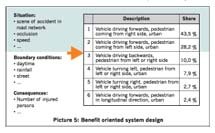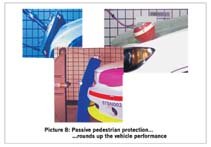Pedestrian Protection
 A new Global Technical Regulation on pedestrian protection was just recently created. It focuses on the situation of a pedestrian being hit by a vehicle and requiring measures to reduce the consequences of this impact. Most efforts in this regard are diverted towards the bonnet of the vehicle in order to reduce the acceleration forces on the pedestrian’s head during the contact with the hood. In the respective test scenario, bullets in form and weight equivalent to an average human head, are fired against various target points on a bonnet (see also picture 8). The metal sheet bends down and thus, absorbs the kinetic energy of the head. In cars with aerodynamic front ends and bigger engines, there is not much space underneath the hood to allow for enough crush room. Therefore, some cars have to be equipped with a sensitive bumper that detects the impact on a pedestrian and lifts up the bonnet pyrotechnically a few inches to allow for that space. Such a system is installed in BMW 5 series vehicles that achieved one of the best pedestrian protection ratings in EuroNCAP ever. On the other hand, the contact on the hood in reality is a rather rare event. In only approximately 6% of the pedestrian fatalities, the injuries are due to the head striking the bonnet. This number does not yet contribute to the fact that a large number of fatalities occur during a secondary impact of the pavement. Considering this would even reduce the 6% further down.
A new Global Technical Regulation on pedestrian protection was just recently created. It focuses on the situation of a pedestrian being hit by a vehicle and requiring measures to reduce the consequences of this impact. Most efforts in this regard are diverted towards the bonnet of the vehicle in order to reduce the acceleration forces on the pedestrian’s head during the contact with the hood. In the respective test scenario, bullets in form and weight equivalent to an average human head, are fired against various target points on a bonnet (see also picture 8). The metal sheet bends down and thus, absorbs the kinetic energy of the head. In cars with aerodynamic front ends and bigger engines, there is not much space underneath the hood to allow for enough crush room. Therefore, some cars have to be equipped with a sensitive bumper that detects the impact on a pedestrian and lifts up the bonnet pyrotechnically a few inches to allow for that space. Such a system is installed in BMW 5 series vehicles that achieved one of the best pedestrian protection ratings in EuroNCAP ever. On the other hand, the contact on the hood in reality is a rather rare event. In only approximately 6% of the pedestrian fatalities, the injuries are due to the head striking the bonnet. This number does not yet contribute to the fact that a large number of fatalities occur during a secondary impact of the pavement. Considering this would even reduce the 6% further down.
Preventive pedestrian protection
 Even though every life counts, it can be stated that the payout for the effort of such Passive Safety solutions is rather low. Analysing pedestrian accidents in detail shows that in about 60% of the cases, the pedestrian crosses a rather straight road without much sight obstruction for the driver of the vehicle. There is a good chance for new video systems to detect a large sum of these incidents early enough to at least warn the driver or maybe, even conduct autonomous vehicle action. Cars today are already equipped with cameras in the windshield for a number of reasons or functions: Cameras already detect the speed signs and alert the driver when he/she is going faster than is allowed. Cameras monitor the lane markings on the road and support the driver in keeping his/her lane. They detect other traffic and allow for automatic high beam lights whenever there is no risk to blind other traffic participants. Cameras, in the near future, can also be used to detect passengers on the road or on the side walk intending to cross the road. The benefit from such systems is expected to be much higher than the one from pure Passive Safety features.
Even though every life counts, it can be stated that the payout for the effort of such Passive Safety solutions is rather low. Analysing pedestrian accidents in detail shows that in about 60% of the cases, the pedestrian crosses a rather straight road without much sight obstruction for the driver of the vehicle. There is a good chance for new video systems to detect a large sum of these incidents early enough to at least warn the driver or maybe, even conduct autonomous vehicle action. Cars today are already equipped with cameras in the windshield for a number of reasons or functions: Cameras already detect the speed signs and alert the driver when he/she is going faster than is allowed. Cameras monitor the lane markings on the road and support the driver in keeping his/her lane. They detect other traffic and allow for automatic high beam lights whenever there is no risk to blind other traffic participants. Cameras, in the near future, can also be used to detect passengers on the road or on the side walk intending to cross the road. The benefit from such systems is expected to be much higher than the one from pure Passive Safety features.
Use the driver´s abilities!
 In the long history of Passive Safety, the engineers have learned to equate car occupants with dummies. In the few milliseconds of a crash there is no such thing like intended behaviour. The occupant is nothing but a kinetic mass moving under the influence of the huge accelerations. Some experts still try to use these rules with preventive protection, as they are used to, in Passive Safety. They require automatic systems that reliably enough detect pedestrians and apply the brake automatically. This, though, demands highly reliable and precise sensor systems. Systems can come faster to the market though, if we make advantage of the abilities of the human being behind the wheel. The driver might have missed the criticality of a certain situation because of different reasons. If the system alerts him/her in time, prepares the brakes for immediate full brake power as soon as the driver applies the brake pedal and lets the driver make the final decision on how to react, faster and more benefits can be gained.
In the long history of Passive Safety, the engineers have learned to equate car occupants with dummies. In the few milliseconds of a crash there is no such thing like intended behaviour. The occupant is nothing but a kinetic mass moving under the influence of the huge accelerations. Some experts still try to use these rules with preventive protection, as they are used to, in Passive Safety. They require automatic systems that reliably enough detect pedestrians and apply the brake automatically. This, though, demands highly reliable and precise sensor systems. Systems can come faster to the market though, if we make advantage of the abilities of the human being behind the wheel. The driver might have missed the criticality of a certain situation because of different reasons. If the system alerts him/her in time, prepares the brakes for immediate full brake power as soon as the driver applies the brake pedal and lets the driver make the final decision on how to react, faster and more benefits can be gained.
Cooperative Systems
Still, in frequent cases the pedestrian cannot be seen in time, though. We all know the situation of kids running through parking cars and suddenly appearing in the driveway. Neither a driver nor a camera system can detect these situations early enough. For such cases, the research engineers are working on communication systems between the car and pedestrians. In one such research project named “Amulett”, a group of car manufacturers and parts suppliers has developed a transponder-based system in which pedestrians carry a small RFID (Radio Frequency Identification) tag e.g. installed in their cell phone, inserted in a credit card in the wallet or in a kid´s school bag which can communicate with a receiver in the car. Pedestrians can be identified without the need of having visual contact.
Passive Safety is necessary
 All the above stated arguments do not intend to dispute the need for certain Passive Safety preparations in the vehicle. Collision mitigation system will reduce the impact speed and thus, reduce the risk of fatal injuries. In order to diminish the number of non life-threatening injuries especially to the lower extremities and/or the pelvis region, certain soft structure solutions in the bumper and very front end area appear adequate.
All the above stated arguments do not intend to dispute the need for certain Passive Safety preparations in the vehicle. Collision mitigation system will reduce the impact speed and thus, reduce the risk of fatal injuries. In order to diminish the number of non life-threatening injuries especially to the lower extremities and/or the pelvis region, certain soft structure solutions in the bumper and very front end area appear adequate.
It is obvious that even with all the collision mitigation or collision avoidance system as described above, the risk for hitting a vulnerable road user can only be reduced but not eliminated. In cases like the one in picture 7, analysed by the accident research team of BMW, there was hardly any time for either the driver or a technical system to react fast enough to avoid the accident between the car and the bicyclist. For such cases, protective elements in the front end of the vehicle will be needed as well. But the above given arguments shall explain why these functions should not be on top of the priority list but rather at the end.
Future course of action
The example of pedestrian protection shows the necessary mind change in vehicle safety. The progress in Passive Safety has reached a top level, already. The future lies in preventive safety systems for collision mitigation and even further for collision avoidance. The priority list should read as follows:
- Improvement in infrastructure. The benefit gained in Europe can be used as a good practice example for emerging countries as well.
- Soft vehicle front ends with protection performance for lower extremity injuries. These are not life-threatening injuries but they can cause strong impairments for the life of the victim. This requirement though stands in contradiction to cost of ownership reduction requirements which demand stiffer bumpers to reduce the repair costs.
- Preventive Safety systems that alert the driver and prepare the brakes. The final decision on how to react is left with the driver.
- Autonomous braking systems that automatically initiate an emergency braking. If the driver does not react at all and the criticality of the situation gets to a point where a conflict is unavoidable, the final decision shall be made by the system.
- Additional protection elements in the front area. Depending on the car design, the shape of the front end, the angle of the windshield and other factors for some cars, additional Passive Safety equipment may be adequate.
A lot of work is still to be done. Not only do the research engineers have to do their jobs properly in order to bring systems to the market that fulfill all the tough requirements of the automotive world, but legal authorities and test institutes also have to accept and accomplish new test scenarios where preventive safety systems are allowed to be kept active in crash tests. Standards have to be created for the automobile manufacturers and suppliers to have clear and fixed targets to develop for. There is still a long way to go. But the revolution has already started.
Klaus Kompass Vice President – Vehicle Safety BMW Group Munich, Germany
 TrafficInfraTech Magazine Linking People Places & Progress
TrafficInfraTech Magazine Linking People Places & Progress


